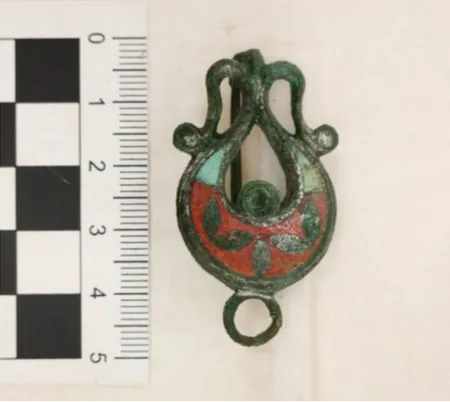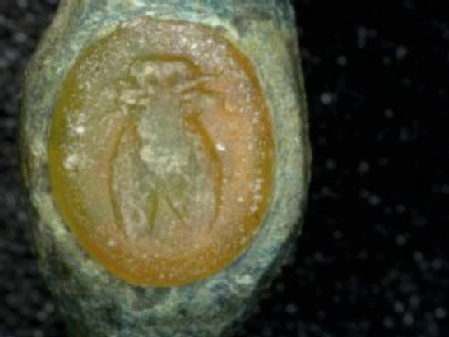Evidence of Roman Occupation near to the Lunt Roman Fort
Baginton, Lunt Roman Fort
For a detailed account of Lunt Roman Fort, its creation, life, design and archaeology, follow this link.
Baginton - Roman occupation East of the Lunt Roman Fort, Warwickshire
Excavation of the site east of the Lunt over a number of seasons has revealed an impressive range of finds dating from the Neolithic through to the Anglo-Saxon periods. Excavations have uncovered a series of possible Neolithic pits with flint artefacts, a Bronze Age round barrow, a Roman cremation cemetery and houses and a small cemetery of Anglo-Saxon date.
The Roman cremation cemetery contained over 60 burials, some with offering pots, personal items and cremation urns, which was likely to have been associated with the Lunt Roman Fort, c.350m to the west. Remains of five Anglo-Saxon houses and twelve burials were also recorded. Some of the graves contained grave goods, which included complete pots and a hanging bowl.
2012 Season
Evidence uncovered during the 2012 season revealed Roman activity in a number of the excavated trenches, unsurprising given the proximity to Lunt Roman Fort. Roman remains included two cremations, a small pit and three possible ditches which were probably boundary features.
One adult cremation (Trench 180) was buried in an urn that had been placed into a pit and then subsequently backfilled. The two deposits associated with it were sufficiently distinct to suggest two different treatments/actions, the first being the burial of an urn containing cremated human remains that had been deliberately collected from the pyre and the second the deposition of the collected pyre debris; fuel waste, remaining fragments of human bone and remnants of the offering, or offerings made at the time of cremation.
The other cremation (Trench 181), which lay 40m to the NE, was not associated with any finds and was probably buried in an organic container or directly into the ground. This implies that there were two subtly different practices occurring. The cremations may be part of a small enclosed area with others present in the vicinity.
A later Anglo-Saxon cemetery on the site could have been located in reference to the Roman activity, indicating an awareness of it (either that or the locations of burials could have been determined by proximity to a local road).
The small pit in Trench 155, which contained pottery of late Iron Age (see section on Prehistory) to early Roman date may be an isolated feature or other similar features may exist in the area.
[Source: Oxford Archaeology South, 2012, Coventry Gateway Zones A and B: Archaeological Evaluation Report, p.25 (--EVALUATION REPORT). SCT24].
2017 Season - excavation by Archaeology Warwickshire
In 2017 a very large area was excavated by Archaeology Warwickshire in the same general area to the east of the Lunt Roman fort in advance of the construction of a new Jaguar Land Rover facility, the site having previously been evaluated by Oxford Archaeology in 2012. The initial 2012 dig had identified a few features and, perhaps most importantly, uncovered a cremation cemetery. It was thought likely that this was associated directly with the Roman fort and was therefore likely to be relatively early in date and to possibly have been mainly for Roman soldiers. The Lunt is known to have had an adjacent vicus (a settlement close to a larger settlement, often arising to serve the requirements of the larger settlement which was often a fort or garrison) so it is possible that the cemetery may have been linked to that.
The cremation cemetery proved to contain over sixty burials, many in pots. The area had been ploughed throughout the medieval period and so some of the burials had been partially truncated. However, as the site consisted mainly of sand, which is easy to dig even without modern tools, and other burials had been buried at a greater depth and so survived intact. Items within burials included numerous complete pots, two mirrors, two glass bottles, brooches, the odd coin (one definitely of Vespasian - emperor AD69-79), pins, a ring with an intaglio and the remains of at least two copper bound boxes. The star feature consisted of a large pit (below) with 23 near complete pots and an oil lamp. Human bone survived within the cremations as the chemical changes caused by burning make it almost impervious to the very acidic sandy geology.

Excavations at baginton (Image: copyright Archaeology Warwickshire)
Some finds from the site

One of the brooches from the above pit, after conservation
(Image copyright Warwick County Council, taken from Roman and Anglo-Saxon artefacts found in Baginton - BBC News).

Intaglio ring after conservation, the design can now be seen to be a wonderful bee
(Image: copyright Archaeology Warwickshire)
Further Reading
https://www.bbc.co.uk/news/uk-england-coventry-warwickshire-50809706
https://bwas-online.co.uk/excavations-adjacent-lunt-roman-fort-baginton/
Baginton - Site of Roman Settlement to East of Oak Farm
[Ordnance Survey Grid Reference SP 34 74]
Part excavation of a Roman settlement uncovered various features and finds. These included wells and/or pits containing Roman pottery, occupational and building debris, coins and a brooch. The site is located 200m southeast of the church at Baginton.
Baginton - Excavation of Roman Settlement to North of Home Farm
[Ordnance Survey Grid Reference SP 34 74]
Excavation of a Roman settlement uncovered wells pits and a ditch, together with brooches and a quantity of pottery including Samian ware, all probably of Flavian date (i.e. around AD69-96). The site is north and northeast of the church at Baginton.

